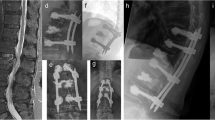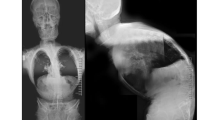Abstract
Sagittal balance and its relationship with back pain and functional outcomes has become an important factor in the management of thoracolumbar fractures. The kyphosis threshold at the thoracolumbar junction (TLJ) that produces a significant functional impairment remains unclear. Ninety-four patients who were treated surgically for TLJ fractures were evaluated after a follow-up period of 2–10 years. Functional evaluation based on the Oswestry and Hannover Scores (HS) was performed. Additionally, such patients underwent clinical and radiological evaluation. A significant inversely proportional correlation between the HS and the degrees of local kyphosis (“K-Angle”) (p = 0.0172) was found. A significant directly proportional correlation between Oswestry Score and “K-Angle” (p = 0.0142) was found. Significantly poorer scores with both measurement tools (Hannover and Oswestry Scores) were found in patients with a kyphosis higher than 12°.



Similar content being viewed by others
References
Alanay A, Acaroglu E, Yazici M et al (2001) Short-segment pedicle instrumentation of thoracolumbar burst fractures: does transpedicular intracorporeal grafting prevent early failure? Spine 26:213–217
Knop C, Fabian H, Bastian L et al (2001) Late results of thoracolumbar fractures after posterior instrumentation and transpedicular bone grafting. Spine 26:88–99
McCormack T, Karaikovic E, Gaines RW (1994) The load-sharing classification of spine fractures. Spine 19:1741–1744
McLain RF, Sparling E, Benson DR (1993) Early failure of short-segment pedicle instrumentation for thoracolumbar fractures. A preliminary report. J Bone Jt Surg (Am) 75-A:162–167
McLain R (2004) Functional outcome after surgery for spinal fractures: return to work and activity. Spine 29:470–477
Alanay A, Yazici M, Acaroglu E et al (2004) Course of nonsurgical management of burst fractures with intact posterior ligamentous complex: an MRI study. Spine 29:2425–2431
Cantor JB, Lebwohl NH, Garvey T et al (1993) Nonoperative management of stable thoracolumbar burst fractures with early ambulation and bracing. Spine 18:971–976
Chow GH, Nelson BJ, Gebhard JS et al (1996) Functional outcome of thoracolumbar burst fractures managed with hyperextension casting or bracing and early mobilization. Spine 21:2170–2174
Gertzbein S (1992) Scoliosis research society: multicenter spine fracture study. Spine 17:528–540
Tropiano P, Huang R, Louis C et al (2003) Functional and radiographic outcome of thoracolumbar and lumbar burst fractures managed by closed orthopaedic reduction and casting. Spine 28:2459–2465
Wood K, Butterman G, Mehbod A et al (2003) Operative compared with nonoperative treatment of a thoracolumbar burst fracture without neurological deficit. J Bone Jt Surg (Am) 85-A:773–781
Knop C, Oeser M, Bastian L et al (2001) Entwicklung und Validierung des VAS-Wirbelsäulenscores. Unfallchirurg 104:488–497
Fairbank JCT, Pynsent PB (2000) The Oswestry Disability Index. Spine 25:2940–2953
Kuklo T, Polly D, Owens B et al (2001) Measurements of thoracic and lumbar fracture kyphosis: evaluation of intraobserver, interobserver, and technique variability. Spine 26:61–66
Magerl F, Aebi M, Gertzbein S et al (1994) A comprehensive classification of thoracic and lumbar injuries. Eur Spine J 3:184–201
Lazennec JY, Ramare S, Arafati N et al (2000) Sagittal alignment in lumbosacral fusion: relations between radiological parameters and pain. Eur Spine J 9:47–55
Roussouly P, Gollogly S, Berthonnaud E et al (2005) Classification of the normal variation in the sagittal alignment of the human lumbar spine and pelvis in the standing position. Spine 30:346–353
Vialle R, Levassor N, Rillardon L et al (2005) Radiographic analysis of the sagittal alignment and balance of the spine in asymptomatic subjects. J Bone Jt Surg (Am) 87-A:260–267
Koller H, Acosta F, Hempfing A et al (2008) Long-term investigation of nonsurgical treatment for thoracolumbar and lumbar burst fractures: an outcome analysis in sight of spinopelvic balance. Eur Spine J 17:1073–1095
Stolze D, Harms J (1999) Correction of traumatic deformities. Principles and techniques. Der Orthopäde 28:731–745
Jackson RP, Hales C (2000) Congruent spinopelvic alignment on standing lateral radiographs of adult volunteers. Spine 25:2808–2815
Jackson RP, Kanemura T, Kawakami N et al (2000) Lumbopelvic lordosis and pelvic balance on repeated standing lateral radiographs of adult volunteers and untreated patients with constant low back pain. Spine 25:575–586
Barrey C, Jund J, Noseda O et al (2007) Sagittal balance of the pelvis-spine complex and lumbar degenerative diseases. A comparative study about 85 cases. Eur Spine J 16:1459–1467
Kumar MN, Baklanov A, Chopin D (2001) Correlation between sagittal plane changes and adjacent segment degeneration following lumbar spine fusion. Eur Spine J 10:314–319
Oda I, Cunningham B, Buckley R et al (1999) Does spinal kyphotic deformity influence the biomechanichal characteristics of the adjacent motion segments? An in vivo animal model. Spine 24:2139–2146
Glassman SD, Bridwell K, Dimar JR et al (2005) The impact of positive sagittal balance in adult spinal deformity. Spine 30:2024–2029
Folman Y, Gepstein R (2003) Late outcome of nonoperative management of thoracolumbar vertebral wedge fractures. J Orthop Trauma 17:190–192
Oner FC, van Gils APG, Faber JAJ et al (2002) Some complications of common treatment schemes of thoracolumbar spine fractures can be predicted with magnetic resonance imaging. Spine 27:629–636
Mumford J, Weinstein JN, Spratt KF et al (1993) Thoracolumbar burst fractures: the clinical efficacy and outcome of nonoperative management. Spine 18:955–970
Sanderson PL, Fraser RD, Hall DJ et al (1999) Short segment fixation of thoracolumbar burst fractures without fusion. Eur Spine J 8:495–500
Siebenga J, Leferink VJ, Segers MJ et al (2006) Treatment of traumatic thoracolumbar spine fractures: a multicenter prospective randomized study of operative versus nonsurgical treatment. Spine 31:2881–2890
Wood KB, Bohn D, Mehbod A (2005) Anterior versus posterior treatment of stable thoracolumbar burst fractures without neurologic deficit: a prospective, randomized study. J Spinal Disord Tech 18(Suppl):S15–S23
Korovessis P, Baikousis A, Zacharatos S et al (2006) Combined anterior plus posterior stabilization versus posterior short-segment instrumentation and fusion for mid-lumbar (L2–L4) burst fractures. Spine 31:859–868
Briem D, Lehmann W, Ruecker AH et al (2004) Factors influencing the quality of life after burst fractures of the thoracolumbar transition. Arch Orthop Trauma Surg 124:461–468
Conflict of interest
The corresponding author developed this study in the frame of a research fellowship supported by an academic institution without relationship with the biomedical or pharmacological industry (Deutscher Akademischer Austauschdienst). No other financial support, direct or indirect, was received by any of the authors.
Author information
Authors and Affiliations
Corresponding author
Rights and permissions
About this article
Cite this article
Schulz, R., Melcher, R.P., Garib, M.C. et al. Does kyphotic deformity correlate with functional outcomes in fractures at the thoracolumbar junction treated by 360° instrumented fusion?. Eur J Orthop Surg Traumatol 24 (Suppl 1), 93–101 (2014). https://doi.org/10.1007/s00590-014-1435-y
Received:
Accepted:
Published:
Issue Date:
DOI: https://doi.org/10.1007/s00590-014-1435-y




